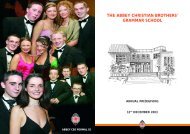GCSE Revision Advice - The Abbey Christian Brothers' Grammar ...
GCSE Revision Advice - The Abbey Christian Brothers' Grammar ...
GCSE Revision Advice - The Abbey Christian Brothers' Grammar ...
Create successful ePaper yourself
Turn your PDF publications into a flip-book with our unique Google optimized e-Paper software.
investigate experimentally:− reduction of copper(II) oxide using hydrogen; and− burning of magnesium and sulfur in air (oxygen);recognise and explain redox as a process involving electron transfer and be able toidentify and explain the oxidation and reduction processes from a redox equationrecognise and explain important oxidation and reduction reactions in industrialprocesses, to include iron and aluminium manufacture, and the Haber process.Learning Intentions for Hard and Soft WaterI will be able to ….recall that the relative atomic mass of an atom is the mass of the atom comparedwith that of the carbon-12 isotope, which has a mass of exactly 12;collect and use quantitative data from the Periodic Table to calculate relativeformula masses (relative molecular masses);understand that the relative formula mass of a substance in grams is known asone mole of that substance;convert the given mass of a substance to the amount of the substance in moles(and vice versa) by using the relative atomic or formula masses;understand the importance of scale in chemistry in terms of calculating molesfrom masses given in tonnes and kilograms, for example in industrial processes;understand that no atoms are lost or made in a chemical reaction and hence it ispossible to interpret equations quantitatively;calculate the reacting masses of reactants or products, given a balanced symbolequation and using moles and simple ratio ;understand the term concentration of a solution expressed in moles per litre(mol/dm3) – questions on titrations will not be asked, but concentrations ofchemicals in solution may be given in moles per litre (mol/dm3) if this isappropriate; andunderstand that when a solution is diluted the concentration changes but the totalnumber of moles of solute does not, for example when 100 cm3 of 0.2 mol/dm3solution of hydrochloric acid is diluted with deionised water to 200 cm3, the newconcentration is 0.1 mol/dm3.Learning Intentions for Quantitative ChemistryI will be able to ….recall that the relative atomic mass of an atom is the mass of the atom comparedwith that of the carbon-12 isotope, which has a mass of exactly 12;collect and use quantitative data from the Periodic Table to calculate relativeformula masses (relative molecular masses) ;understand that the relative formula mass of a substance in grams is known asone mole of that substance;convert the given mass of a substance to the amount of the substance in moles(and vice versa) by using the relative atomic or formula masses ;understand the importance of scale in chemistry in terms of calculating moles
















